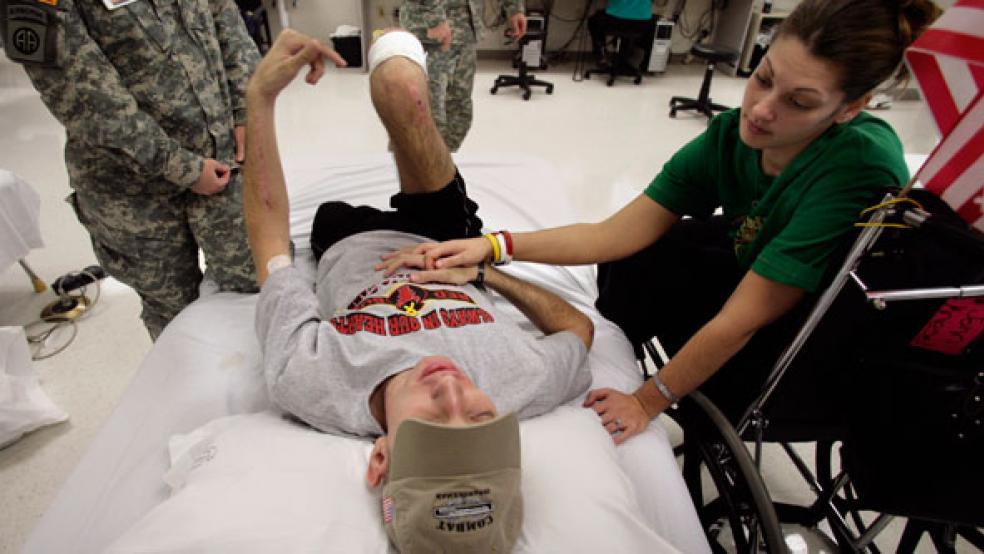As an example of how the normally sclerotic Congress can act extremely quickly when properly motivated, both chambers passed bills this week to ameliorate the Veterans Affairs health services scandal.
The Senate version, negotiated by the mismatched pair of Bernie Sanders (I-VT) and John McCain (R-AZ), spends $500 million on more doctors for the VA and authorizes leases for 26 new medical facilities. But until the expansion gets up and running, between now and 2016, VA recipients who run into long delays or live more than 40 miles from a clinic would be able to access private care facilities like community health centers or private hospitals. The Senate approved the measure 93-3 on Wednesday. A similar House bill, passed unanimously on Tuesday, also allows for VA-paid care for veterans at private facilities for two years.
Related: Disapproval of Obama’s VA Management Could Hurt Dems in Midterms
There are other pieces to the bills (like removing the counter-productive wait time bonus system that led to staffers cooking the books, improvements to the post-9/11 GI Bill for higher education, and greater flexibility to fire senior VA leadership), but this is the main feature — a stopgap to eliminate long wait times at the VA by allowing private access.
Congress moved so fast that they skipped the part where they wait for the Congressional Budget Office to deliver a cost estimate. And CBO sprung a bit of a surprise late Wednesday. After an initial estimate claiming that a trivial amount of already appropriated but “unobligated” funds would cover the cost, CBO Director Doug Elmendorf wrote a letter to Sanders more fully analyzing the Senate version of the bill.
In its “preliminary and partial assessment,” CBO estimated that enacting the private care portion of the bill “would increase direct spending by roughly $35 billion over the 2014-2024 period,” Elmendorf wrote, using the standard 10-year budget window even though the private-care coverage would only be in place for a couple of years. CBO believes these costs will build over the two-year time frame, rising to $25 billion in 2016. For context, the VA currently spends $44 billion in total each year on health care services to veterans.
The reason for this ramp-up, Elmendorf asserted, is increased utilization. CBO estimates that veterans would increase the care they receive from the VA by 60 percent, and that others who hadn’t enrolled with the VA would come out of the woodwork and take advantage of the new access. Some would shift to the VA from Medicare, saving funds for that program. But over time, CBO predicts a doubling in the outlays for VA health care, an additional $50 billion a year. Elmendorf qualifies these figures by calling them highly uncertain, and says they “should be viewed as falling in the middle of a wide range of possible outcomes.”
That said, they have major implications. First of all, Congress appeared to be expecting a low-cost bill, with appropriations made out of emergency funds. Sanders estimated a $2 billion price tag. Even with that smallish estimate, the Senate had to hold a vote waiving “paygo” rules, passing the bill without offsetting the spending, and 19 Republicans voted against doing that. With a cost 17 times higher, and the House fully expecting to use existing funding to satisfy the bill, this throws the orderly path to passage into serious question.
Because caring for veterans is such a high-priority issue, and both parties want to show their commitment to the troops, some form of this will probably pass, and probably without offsets. Injecting $35 billion over the next three years into an economy under the burdensome fiscal restraints of a previously authorized spending cap will brighten — just slightly — the outlook of Keynesians who believe more spending will help kick-start a still-sluggish economy (though most of the benefits wouldn’t come until 2016).
The bigger question, though, is how much of this funding will go through the higher-cost private health care system, and who will benefit. The two-year time limit offers a little experiment to test the effectiveness of VA care versus that private system.
Related: Lots of Ideas, No Quick Fix for VA Health Care
On one side, free-market advocates will get to see if the VA was essentially rationing care, and if a large shift to alternatives, as per CBO’s prediction, shows the superior nature of private systems. There are limits to this argument. First of all, the VA internal audit found 57,000 veterans waiting over 90 days for their first appointment out of 8.4 million enrollees, or 0.6 percent. Some patients may have neglected treatment out of fear of long lines, but Elmendorf’s numbers suggest a massive amount of pent-up demand, which we’ll have to see play out.
In addition, long wait times at the VA have much to do with an increase in returning veterans from Iraq and Afghanistan, and even more to the graying of older baby boom-age Vietnam veterans (in fact, Phillip Longman argues that the “systemic” wait time problem is mainly a function of high demand at Sun Belt facilities, where a lot of baby boomer retirees live). VA funding has yet to increase at the levels needed to accommodate the demand. If you want to fight wars around the world, you have to factor in the cost of caring for those doing the fighting. We also don’t know how this will affect so-called “rationing” throughout the private system, since unlike the VA, private hospitals don’t have to track wait times.
Related: 100,000 Vets Experience Long Wait Times for Health Care
On the other side, this will serve as an experiment about the cost and quality of the private system. We will be able to judge side-by-side what a treatment costs inside VA facilities versus what it costs at a private hospital. We will see whether the VA is best equipped to deal with unique and complex battlefield injuries and pathologies, or whether the private system can handle them.
We already have some statistics. The World Bank estimates per capita health spending in the United States at $8,895 per person; for VA patients, it’s $5,200. In addition, the VA does a fair amount of outsourcing to private facilities already, and a 2009 Inspector General report showed that 37 percent of those payouts were improper. It’s unclear whether CBO factored the higher cost of care outside the VA system into their projections. How much additional waste and abuse will accelerated privatization create?
VA health care holds a reputation for high quality (once it can be accessed), in part because of its strongly coordinated system. The caregivers work for the VA, they have incentives to provide the best available care rather than what maximizes private profits, they specialize in the particular battlefield traumas, and they use leading-edge electronic medical records, enabling them to treat patients without duplication or overuse of services. Opening this up to hospitals without the same information could not only cost more, it could give veterans worse care.
Related: VA Scandal Exposes Flaws of Single-Payer Health Care
The partial VA privatization is supposed to be temporary, but once implemented, it may prove difficult to remove. If properly resourced, by all accounts the VA delivers better care for less. While it makes sense to do what’s necessary in the immediate term to work through the backlog for veterans, we’re going to come away with a mountain of evidence on how private treatment affects cost and quality of outcomes relative to an integrated public system. We should use the data to inform health care policy in the future. More data should make for better decisions.
Top Reads for The Fiscal Times:






